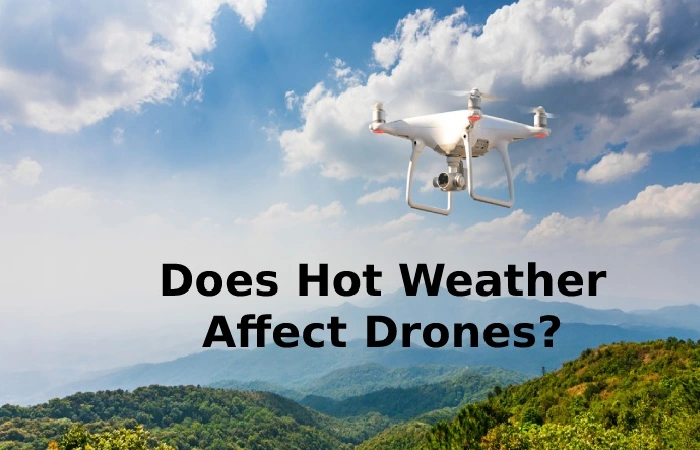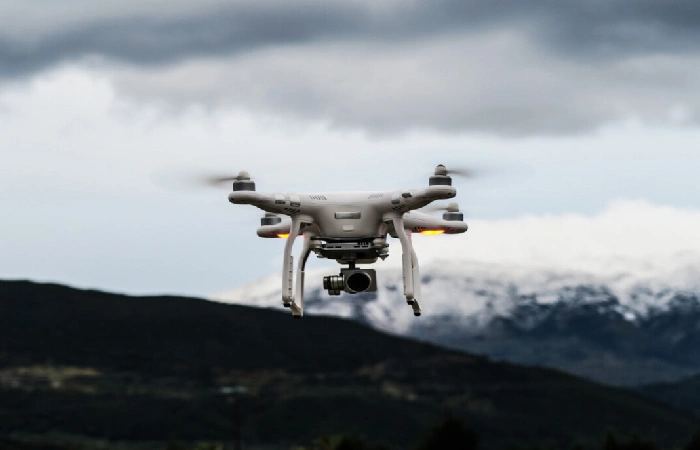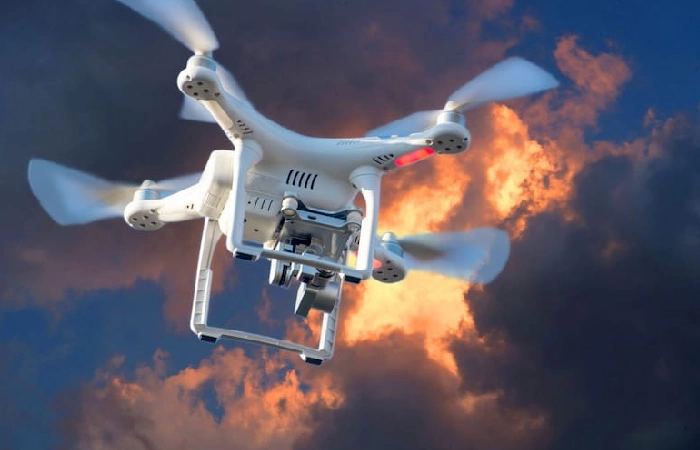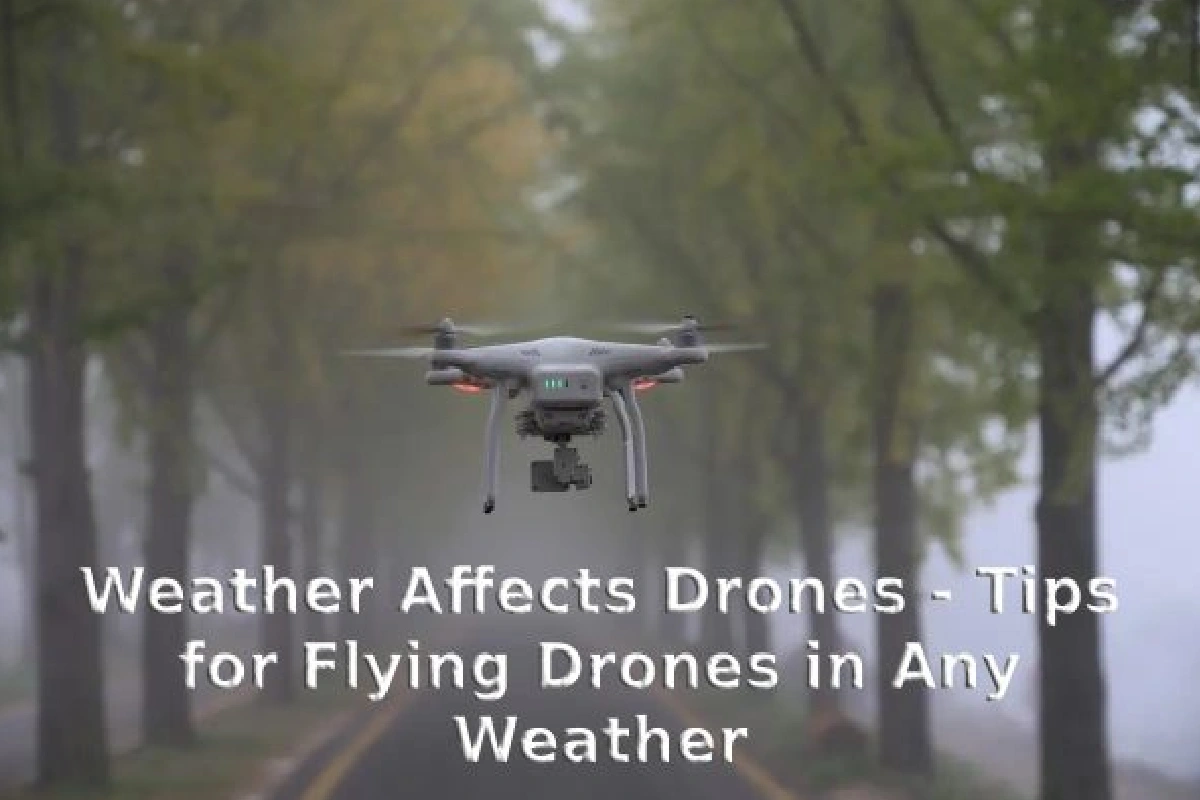About Weather Affects Drones
Weather affects drones: Weather is a significant factor that affects a drone after launch. Therefore, drone pilots need to take weather conditions seriously. Unlike licensed airline pilots who have been extensively trained to understand the weather, you may not understand every detail about the weather. However, there are some primary weather conditions that you can and should understand and how they affect your drone.
All types of weather conditions, including extreme heat and cold, wind, rain, and snow, affect the safety and comfort of flying your drone. Avoiding flying in severe or bad weather is a good idea.
Does Hot Weather Affect Drones?

It is not suitable to fly your drone in scorching weather as the heat can adversely affect different parts of your drone. If should be careful if you are in an area with roasting weather. When a drone flies in warm weather, the air is less solid, making it harder for its propellers to produce lift. The drone’s batteries can overheat if it is having trouble generating lift.
This shortens the flight time. In addition to the timing problem, overheating can damage wiring connections or electronics. If the battery gets too warm, your drone may catch fire or explode, causing severe damage and loss.
To avoid this, do not fly in sweltering conditions. It would help if you also gave your drone more time to calm down between flights and formerly charging the battery.
The color of your drone is an additional issue that plagues drones in scorching climates. If your drone is dark, like black or grey, it will heat up even faster. For this reason, it is advisable to opt for white Drones, which do not absorb heat as quickly, mainly if your flight area is hot record the time.
What to do if You want Lengthier Flights in Hot Weather?
If you want a long flight in hot conditions, take the time for early and detailed preparation. Although the time will still be shorter, the following tips will help you make the most of the time and save battery.
- Keep the drone moving and avoid hovering.
- Make sure your battery is fully charged before you fly
- Also, check the battery voltage.
- Be aware of battery temperatures.
- Make sure the batteries stay calm until it’s time to fly your drone
Helpful Tip
- To keep the drone and battery cooler, do the following:
- Confirm compass calibration is up to date
- Set the home point before a flight
- Adjusted for height on the way home.
- Check battery charge
- Check your camera settings
These guidelines may seem simple, but they will help keep your drone stable and safe. So you don’t have to worry about what might happen. However, in extremely high temperatures, you should stay indoors and not endanger your drone.
Does Rainy Weather Affects Drones?
There is a joint question; the simple answer is that it is contingent on the type of drone. Some are waterproof, so you may not have to worry too much. But, in common, it is advisable to keep your UAV dry. This is mainly due to the motor and electric parts. Before you fly your drone in rainy weather, you need to understand the potential impact on your drone.
If Your drone may crash, you can fly it in rainy weather. Due to rainwater, there is a high possibility that its electrical components will short circuit. Sometimes, short courses can even occur when the drone lands on wet grass.
The project of your drone is another consideration, as it will determine its sensitivity to water. For example, if the ventilation openings on your drone are large, rainwater will quickly enter the electric motor. When this happens, the drone’s receiver is further affected as the signal is interrupted, making the drone uncontrollable. This could result in signal loss or collision.
It can get even worse when rainwater directly hits the power distributor and shorts out there. A short circuit causes more damage by burning PCB components or melting wires.
Strong winds often accompany rainy weather, and that is also another challenge. When there is wind, you can quickly lose control of your drone. Even if rainwater is too heavy, its weight can cause
Essential Tips for Flying Drones in Rainy Weather

Although rainy weather presents many challenges, you can still fly and enjoy your drone if you are well-prepared. Here is some stuff you can do to be harmless:
Always Fully Charge Batteries
When it’s cold, drone batteries perform less well, meaning they don’t last as long as usual. To avoid this, fully charge the battery to get the most out of your planned flight time. This is a golden top-secret for flying drones in rainy weather.
Proper Battery Storage in Winter
As winter temperatures are low, storing batteries in favorable conditions is recommended when not in use. Ensure your batteries are not kept in a cold place to avoid problems that come with winter, including high charge losses. Batteries are ideally stored at an ambient temperature of 25 degrees to keep them in perfect condition for flights in rain or snow.
Monitor the Voltage of the Batteries
This is an additional helpful tip when flying your drone in rainy weather. Paying close attention to battery voltage will prevent rapid depletion by limiting discharge. Most drone apps have a battery-watching feature that helps when it rains.
For example, if your battery voltage drops to 3.1 volts, you may not have enough charge on your way home. Using a drone app to monitor batteries is the most reliable way, as the app has indicators that show the battery status.
Make Sure Batteries Stay Warm
This tip may seem simple, but it should not be overlooked. The drone’s temperature drops in winter, so you are responsible for keeping the batteries warm. This ensures that the effects of cold weather do not affect them and reduces the chance of the battery dying mid-flight.
Does the Wind Affect Drones?
Flying your drone in windy weather can be risky; however, depending on your drone mode and wind speed, you can still pass it. The overall rule of thumb for flying drones in such states is that the wind speed should be no more than two-thirds of the extreme speed of your drone.
Flying is a test that comes with flying drones in windy weather. The drone flies against the wind direction and tries to balance it. Due to its horizontal tilt, it appears to be moving forward, and instead, it is floating. Also, you will notice some loud noises due to the high demand for more electrical power from the propellers and the motor. Because when the drone flies in solid wind, its power consumption increases.
Another thing that will indeed happen is turbulence. It will cause unexpected movements, so you must be careful while the drone is flying. During the confusion, the drone will have a high power demand; therefore, you should plan for shorter flight times. Valuable tips for flying a drone in windy weather
Avoid Strong Winds
For beginners, it is sensible not to fly your drone in winds that surpass 10-15 mph. However, it can increase to 20mph as you get more expert. For example, if your drone is moving at 60 mph, it must weather wind speeds of 32 mph.
Check the Batteries
It would help to keep battery life in mind when flying in the wind. When the drone flies back, it consumes more charge than in good weather.
Please Stabilize the Drone First Before Taking Photos
Once you launch the drone, don’t rush to take photos; stabilize your drone first. If the wind shakes the drone, your photos will be of poor quality, which could cost you money for commercial use.
Block the Wind When the Drone Takes Off
Initiating your drone in windy weather is the hardest part. This is the most probable time for your drone to crash, which could damage the propellers or other components of the drone. However, you can avoid this by standing in front of the drone when it’s time to take off.
Another trick is to launch your drone from an area that blocks the wind, e.g., B. tall buildings. Evoke to stand behind the drone and avoid getting too close to it.
As mentioned above, drones make louder noises when flying in high winds than usual, so don’t be surprised if the motors seem to work harder than expected.
Establish Control Signals
Drones overreact when flying downwind. To escape this, ensure your flight control signals are smooth and watch the drone’s response. You will find that you are moving faster than usual, which tells you that you should be ready to stop longer.
How to Measure the Wind Speed before Flying Your Drone?
You can use the following devices to estimate the wind.
Wind Application
An excellent example of this type of application is UAV forecasting. This is an application that displays the current wind speed. Every drone pilot must have this app to help them plan their flight well.
Beaufort Scale
This descriptive table estimates the wind compared to the condition of a large body of water. Therefore, a drone pilot can use the scales to observe the state of the ocean and determine if it is safe to fly.
Anemometer
An anemometer is an excellent device that measures the wind’s direction, pressure, and speed. Drones are affected by wind but can still fly in inclement weather conditions as long as the tips are followed.
Does Cold Weather Affect Drones?

Winter is here, and you are thinking of going out and letting your drone fly. But there is a problem: you are unsure if it is safe. It depends on how cold it is, and it is unsafe to fly your drone in icy conditions. Cold weather affects drones in several ways, but shallow temperatures and strong winter winds can damage drones.
Drone batteries are the most affected by the cold. Maximum drones have LiPo batteries whose functionality is pretentious by the cold. When it is hard, the batteries cool down, reducing their chemical activity. This reduces flight time, not to mention the risk of sensor, power, and system failure.
Visibility is another challenge in winter weather. Surely you already know that flying your drone in poor visibility is risky, and winter usually brings visibility problems due to fog, mist, or snowfall. Therefore, you should check the visibility conditions; if visibility is poor, you should not fly your drone.
Camera performance is also affected by winter. The snow makes it difficult to see some images, and this is because the camera’s exposure system becomes blurred. You need to adjust the white balance setting if you want better image quality in such a situation.
Helpful tips for flying drones in cold weather: It is a good idea to understand how to deal with the challenges of flying in cold weather. Here are some helpful tips:
Store the Battery Properly
Proper battery storage will determine its survival in cold climates. It is best to keep them in a cool, dry place, and room temperature is appropriate for LiPo batteries.
You should also avoid charging the drone battery when it is too hot or too cold. Also, do not store the battery without it for a long time. Also, keeping loose batteries together could cause a short circuit if their terminals touch and should therefore be avoided.
Avoid Long Flights
Drone batteries drain faster in cold weather, as we mentioned earlier. So plan and keep your flights smaller. This way, you will be exact in your shots and lower the drone without the battery failing.
Warm up the Batteries
Ideally, it would help if you warmed up your drone batteries before you fly. Make sure the temperature reaches around 70 degrees F before launching your drone. There are different types of battery heaters on the market. Otherwise, you can use hand warmers if a battery-powered warmer is unavailable. However, avoiding direct contact between heaters and batteries would be better. You can also wrap them in a scarf to protect them from the heat given off by leg warmers.
Personal Care
It doesn’t always have to be the drone. You are also part of the drone flight, so you must take care of yourself. If your thumbs are frozen, the flight could be compromised. So if it’s freezing, it’s a good idea.
How do you keep Drone Batteries Warm in Cold Weather?
Wrap Them Up
You can use a cloth, scarf, or gloves to wrap the batteries or anything that insulates them to keep them warm.
Buy Self-Heating Batteries
Many types of drones come with self-heating batteries. However, the feature makes them very expensive.
Invest in battery heaters and Decals
These are devices that provide heat to drone batteries. However, you should check the compatibility with your drone before purchasing.
Hand warmers
All drone owners who live in more excellent areas should invest in these. They are helpful for heating drone batteries to the correct temperatures. However, you should avoid placing them on the battery surface, as they can get too hot.
Conclusion
Weather affects drones, the weather has a significant impact on drones as it affects the functionality and safety of a drone. Hot weather causes high power consumption and possible damage to wiring cables. On the other hand, if you fly your drone in cold weather, the batteries drain very quickly, affecting your flight time. Because of the snow, you can’t see the surroundings well either.
Flying your drone in the rain can also short out electrical parts. In short, it is possible to fly drones in all weather conditions as long as the pilot prepares in advance. We hope this article was timely and beneficial for all drone and weather-related things that weather affects drones.



